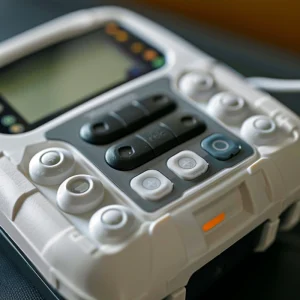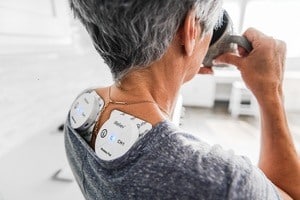Are you struggling with chronic pain and seeking a drug-free solution? Look no further than a TENS unit, a cutting-edge device designed to provide effective pain relief through electrical stimulation.
What is a TENS Unit?
A TENS unit, short for Transcutaneous Electrical Nerve Stimulation, is an advanced technology that utilizes electrical impulses to disrupt the transmission of pain signals to the brain, thereby reducing the perception of discomfort. These versatile devices can be adjusted to different intensity levels and frequencies to cater to individual needs, offering a non-invasive method of pain management.
How Does a TENS Unit Work?
TENS units work by delivering electrical stimulation through electrode pads placed on the skin. These pads are strategically positioned over the area of discomfort, creating a tingling or massaging sensation that can help alleviate neuropathic pain. By adjusting the frequency and intensity settings, users can personalize their TENS therapy to suit their needs, effectively disrupting the transmission of pain signals to the brain.
The electrical impulses from the TENS unit interfere with the pain signals traveling along the nerves to the brain. This interference helps to minimize the perception of pain, providing relief from discomfort. The adjustable settings on TENS units allow users to fine-tune the electrical stimulation to their specific needs, ensuring an optimal pain management experience.

Types of Pain a TENS Unit Can Help With
TENS units are versatile tools that can effectively assist in managing various types of pain, including:
- Back pain: Whether it’s chronic lower back pain, sciatica, or muscle spasms, TENS units can help alleviate discomfort by stimulating the nerves in the affected area.
- Muscle tension: For individuals suffering from muscle tension or strains, TENS units can provide soothing relief by promoting muscle relaxation and reducing spasms.
- Nerve-related discomfort: TENS units can be particularly effective in managing neuropathic pain, such as diabetic neuropathy, by disrupting the transmission of pain signals along the affected nerves.
- Arthritis pain: By targeting the nerves near affected joints, TENS units can help reduce inflammation and alleviate the discomfort associated with arthritis.
- Menstrual cramps: The electrical stimulation provided by TENS units can help relax the muscles in the abdomen, offering relief from menstrual cramps and associated discomfort.
These portable devices work by delivering small electrical impulses through electrodes placed on the skin, helping to disrupt pain signals sent to the brain, making them a practical choice for incorporating into daily pain management routines.
Is a TENS Unit Safe for Everyone?
While TENS units are generally safe for most users, it is essential to consider safety precautions given their portable nature and ease of use. Following the manufacturer’s guidelines and consulting a healthcare professional before starting TENS therapy is recommended to ensure its effectiveness and safety.
It is crucial to avoid using TENS units near sensitive areas like the eyes, head, or heart, or on broken or irritated skin to prevent adverse effects. Individuals with pacemakers, implanted defibrillators, or other electronic medical devices should exercise caution and seek medical advice before using a TENS unit, as the electrical impulses may interfere with the proper functioning of these devices.
Pregnant women should also consult with their healthcare provider before using a TENS unit, as the safety of electrical stimulation during pregnancy is not fully established.
Using a TENS Unit for Pain Relief
Utilizing a TENS unit for pain relief involves proper placement of electrode pads, adjusting device settings for personalized comfort, and experiencing muscle relaxation leading to effective pain reduction.
Step-by-Step Guide to Using a TENS Unit
- Begin by preparing the skin area where you plan to place the TENS electrodes. Clean the skin with a mild soap and water, and ensure it is dry before application.
- Apply the electrode pads to the skin near the area of discomfort. Follow the manufacturer’s instructions for proper placement, as different pain conditions may require specific electrode positions.
- Turn on the TENS unit and gradually increase the intensity to a comfortable level, feeling the pulsing sensation that signals pain relief. Start with a low intensity and gradually increase it until you feel a gentle tingling or massaging sensation.
- Adjust the settings as needed to find the right frequency and intensity for your individual needs. Different frequencies may work better for different types of pain, so experiment to find the most effective settings for your condition.
- Use the TENS unit for the recommended duration, typically 20-30 minutes per session. Some individuals may require longer sessions, but it’s essential to follow the manufacturer’s guidelines and consult with a healthcare professional if you have any concerns.
Best Practices for Using a TENS Unit
Adopting best practices for using a TENS unit can contribute to a pain-free lifestyle, aid in rehabilitation efforts, and complement physical therapy for holistic pain management solutions. Here are some essential best practices to follow:
- Proper electrode placement: Ensure that the electrode pads are positioned correctly on the skin to target the desired area effectively. Consult with a healthcare professional or refer to the manufacturer’s instructions for optimal placement.
- Adjust intensity levels: Start with a low intensity and gradually increase it until you feel a comfortable tingling or massaging sensation. Avoid using excessively high intensities, as this can cause discomfort or muscle contractions.
- Clean the skin regularly: Keep the skin area clean and dry before each use to ensure proper conductivity and prevent skin irritation.
- Replace electrode pads: Replace the electrode pads as recommended by the manufacturer to maintain optimal conductivity and prevent skin irritation.
- Follow usage guidelines: Adhere to the manufacturer’s recommended usage duration and frequency to avoid overuse or potential side effects.
- Consult a healthcare provider: If you have any underlying medical conditions, consult with a healthcare provider before using a TENS unit to ensure it is safe and appropriate for your specific needs.
Utilizing a TENS unit correctly is crucial for maximizing its benefits and ensuring a safe and effective pain management experience.
Benefits of Using a TENS Unit for Pain Relief
The benefits of using a TENS unit for pain relief include effective pain management, precise pain control, non-invasive therapy options, innovative pain relief techniques, and a wide range of relief options to choose from.
Non-Invasive and Drug-Free Pain Relief
One of the most significant advantages of TENS units is their non-invasive and drug-free nature, making them an attractive option for individuals seeking alternative pain management solutions. Unlike medications, which can have potential side effects and risks of dependency, TENS units offer a safe and natural approach to pain relief.
The non-invasive and drug-free nature of TENS units makes them ideal for addressing neuropathy and offering effective pain management solutions through innovative pain relief techniques. These portable devices work by sending electrical impulses through the skin to stimulate nerves, which can help block pain signals from reaching the brain, providing a non-pharmacological option for individuals suffering from neuropathic pain.
By utilizing electrical stimulation to disrupt pain signals, TENS units can provide relief without the need for invasive procedures or potentially harmful medications, making them a valuable addition to any comprehensive pain management plan.
Customizable Settings for Personalized Relief
TENS units offer customizable settings that allow users to tailor their electrotherapy experience, providing personalized pain relief strategies and accommodating various pain relief devices for optimal outcomes. The flexibility of these settings plays a crucial role in ensuring that individuals can fine-tune their electrotherapy sessions to suit their specific needs.
With adjustable intensity levels, users can control the strength of the electrical impulses, ensuring a comfortable yet effective stimulation. Additionally, different frequency settings can be explored to target different types of pain, allowing for a truly personalized approach to pain management.
The ability to customize the settings on a TENS unit enables users to adapt the therapy to their unique pain patterns, intensity levels, and personal preferences, maximizing the chances of achieving effective relief.
Can Be Used Anywhere, Anytime
The portability of TENS units allows for on-the-go pain relief, facilitating pain reduction anytime, anywhere, and showcasing the convenience of advanced pain relief technology at your fingertips. These innovative devices are designed to be compact and lightweight, making them easy to carry in a bag or pocket.
With adjustable settings and various electrode options, individuals can customize their pain relief experience to target specific areas of discomfort efficiently. Whether at home, at work, or on the go, TENS units offer a practical solution for managing chronic pain, allowing users to reclaim control over their daily activities without being limited by discomfort.
The convenience of TENS units extends beyond their portability. Many modern models feature rechargeable batteries, ensuring long-lasting use without the need for frequent battery replacements. Additionally, some units may offer wireless connectivity or mobile app integration, further enhancing their accessibility and user-friendliness.

Potential Side Effects of Using a TENS Unit
While TENS units are generally safe, some potential side effects may include skin irritation, muscle twitching or spasms, and the possibility of interference with medical devices, necessitating caution during usage.
Skin Irritation
Skin irritation caused by TENS units can affect pain threshold perception and may require adjustments in electrical therapy to mitigate discomfort and maintain effective pain management. This side effect can manifest as redness, itching, or a burning sensation at the electrode sites.
To address skin irritation, some potential adjustments in the placement of electrode pads or the intensity of the electrical impulses may be necessary. Using high-quality electrode pads designed for sensitive skin, rotating electrode placement locations, and properly cleaning the skin before application can also help prevent or minimize skin irritation.
If skin irritation persists or worsens, it is advisable to discontinue use and consult a healthcare professional for further guidance.
Muscle Twitching or Spasms
Muscle twitching or spasms resulting from TENS unit use can influence pain perception and may exacerbate existing painful conditions, necessitating monitoring and appropriate adjustments for relief. These muscle contractions triggered by TENS units can vary in intensity and duration, affecting how individuals perceive and experience pain.
In some cases, mild muscle twitching may be a normal response to the electrical stimulation, particularly when using higher intensity settings. However, if the twitching or spasms become excessive or cause significant discomfort, it is recommended to reduce the intensity or adjust the electrode placement.
Consulting with a healthcare professional can help determine the appropriate settings and positioning to minimize muscle twitching while still achieving effective pain relief.
Interference with Medical Devices
Potential interference with medical devices due to TENS unit operation may manifest through altered pain symptoms, necessitating the adaptation of pain relief techniques and strategies to mitigate any adverse effects. This interference can be particularly concerning for individuals using pacemakers, insulin pumps, or other electronic implants, as the electromagnetic signals from the TENS unit may disrupt the functioning of these devices.
If you have an implanted medical device, it is crucial to consult with your healthcare provider before using a TENS unit. They can provide guidance on the appropriate precautions to take, such as maintaining a safe distance between the TENS unit and the implanted device, or recommending alternative pain management methods if necessary.

Choosing the Right TENS Unit for Pain Relief
Selecting the ideal TENS unit for pain relief involves considering different health technology options, evaluating available pain relief products, and assessing various methods to determine the most suitable device for your needs.
Factors to Consider When Choosing a TENS Unit
When selecting a TENS unit, key factors to consider include:
- Pain relief system: Evaluate the effectiveness of the pain relief system provided by the TENS unit. Look for units that offer a wide range of intensity and frequency settings to accommodate various pain levels and types.
- Electrode compatibility: Ensure that the TENS unit is compatible with high-quality electrode pads that are designed for sensitive skin and offer optimal conductivity.
- Pain relief patches: Consider the convenience of pain relief patches or electrode pad options that allow for discreet and convenient use under clothing.
- Battery life: Look for TENS units with long-lasting battery life or rechargeable batteries to ensure uninterrupted use during extended sessions or when on the go.
- User-friendly interface: Choose a TENS unit with an intuitive and easy-to-use interface, featuring clear displays and simple controls for adjusting settings.
- Portability and design: Consider the portability and design of the TENS unit, as you may want to use it while engaging in daily activities or traveling.
The effectiveness of the pain relief system is crucial, as it determines how well the TENS unit can alleviate your discomfort. Additionally, ensuring the compatibility of the electrodes and the convenience of pain relief patches can greatly enhance the overall user experience and effectiveness of the therapy.
Understanding Different Types of TENS Units
Delve into the diverse array of TENS units available, ranging from pain relief stimulators to specialized therapy devices, offering unique solutions tailored to address specific pain relief needs and enhance your overall well-being.
- Basic TENS units: These entry-level devices offer essential features such as adjustable intensity levels and basic frequency settings. They are often more affordable and suitable for mild to moderate pain relief.
- Advanced TENS units: These sophisticated units offer a wider range of customizable settings, including different waveforms, modulation modes, and pre-programmed treatment modes for specific pain conditions. They may also include additional features like built-in timers and memory functions.
- Specialized TENS units: Designed for specific pain conditions or body areas, these units may come with specialized electrode pads or programmed settings tailored for conditions such as arthritis, back pain, or labor pain.
- Wireless TENS units: Offering the convenience of wireless connectivity, these units can be controlled remotely through a mobile app or a separate control unit, allowing for discreet and flexible pain management.
- Combination therapy units: Some TENS units may also incorporate additional therapy modes, such as muscle stimulation, massage, or heat therapy, providing a comprehensive pain management solution.
Understanding these different categories can help individuals make informed choices for effective pain management strategies that align with their specific needs, preferences, and budgets.
Embracing Relief: Unlocking the Power of TENS Units
TENS units have emerged as a game-changer in the field of pain management, empowering individuals to take control of their discomfort and unlock a world of relief. By harnessing the power of electrical stimulation, these innovative devices offer a safe, non-invasive, and customizable solution for those seeking respite from chronic pain.
With their ability to disrupt pain signals, TENS units provide a drug-free alternative to traditional pain management methods, reducing the risk of side effects and dependency associated with medications. The customizable settings and versatility of these devices allow users to tailor their pain relief experience to their specific needs, ensuring optimal comfort and effectiveness.
Furthermore, the portability and convenience of TENS units empower individuals to manage their pain on-the-go, without disrupting their daily routines or limiting their activities. Whether at home, at work, or during travel, these devices offer a discreet and accessible solution for alleviating discomfort.
Embrace the transformative potential of TENS units and embark on a journey towards a life free from the shackles of persistent discomfort. Consult with a healthcare professional to explore the suitability of TENS therapy for your specific condition, and unlock a world of relief through the power of cutting-edge technology.




